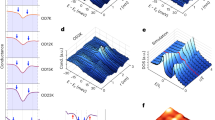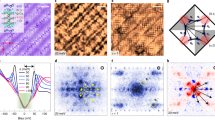Abstract
SINCE the discovery of superconductivity in the layered copper oxide materials1, a number of microscopic models have been proposed. To know which of these should be considered further, it is important to determine empirically the symmetry of the superconducting order parameter (the wavefunction of the superconducting condensate). For some time there has been conflicting experimental evidence as to whether the superconducting condensate has s- or d-wave symmetry2; these terms, strictly correct only in tetragonal symmetry, are commonly used to denote whether the superconducting gap is finite in all directions at zero temperature or contains nodes. Tunnelling data along the c axis of these quasi-tetragonal copper oxides, perpendicular to the CuO2 planes, clearly show an s-wave character3,4. Conversely, tunnelling along the a or b axis of YBa2Cu3O7−δ has indicated a d-wave character of the wavefunction5–7, with one exception8. Here I propose that these and other apparently conflicting results can be explained in a consistent way if there exist in the copper oxide superconductors two condcnsatcs, with different symmetry but the same transition temperature—in other words, if there are two kinds of superconducting gap.
This is a preview of subscription content, access via your institution
Access options
Subscribe to this journal
Receive 51 print issues and online access
$199.00 per year
only $3.90 per issue
Buy this article
- Purchase on Springer Link
- Instant access to full article PDF
Prices may be subject to local taxes which are calculated during checkout
Similar content being viewed by others

References
Bednorz, J. G. & Müller, K. A. Z. Phys. B64, 189–193 (1986).
Beasley, M. R. IEEE Trans. Appl. Supercond. 5, 141–151 (1995).
Sun, A. G., Gajewski, D. A., Maple, M. B. & Dynes, R. C. Phys. Rev. Lett. 72, 2267–2270 (1994).
Murakami, H., Ohbuchi, S., Hiramatsu, S. & Aoki, R. in Proc. 6th Int. Symp. on Superconductivity, Hiroshima, Japan, 1993 93–96 (Springer, Tokyo, 1994).
Wollman, D. A., Van Harlingen, D. J., Lee, W. C., Ginsberg, D. M. & Leggett, A. J. Phys. Rev. Lett. 71, 2134–2137 (1993).
Brawner, D. A. & Ott, H. Phys. Rev. B (in the press).
Kirtley, J. R. et al. Nature 373, 225–228 (1995).
Chaudhari, P. & Lin, S.-Y. Phys. Rev. Lett. 72, 1084–1087 (1994).
Binning, G., Baratoff, A., Hoenig, H. E. & Bednorz, J. G. Phys. Rev. Lett. 45, 1352–1355 (1980).
Schooly, J. F., Hosler, W. R. & Cohen, M. L. Phys. Rev. Lett. 12, 474–475 (1964).
Kresin, V. Z. & Wolf, S. A. Phys. Rev. B46, 6438–6471 (1992).
Battlog, B. Physics Today, June, 44–50 (1991).
Deutscher, G. & Müller, K. A. Phys. Rev. Lett. 59, 1745–1747 (1987).
Deutscher, G. & Simon, R. W. J. appl. Phys. 69, 4137–4139 (1991).
Dimos, D., Chaudhari, P. & Mannhart, J. Phys. Rev. B41, 4038–4049 (1990).
Tsuei, C. C. et al. Phys. Rev. Lett. 75, 593–596 (1994).
Imai, I., Slichter, C. P., Paulukas, A. P. & Veal, B. Appl. magn. Reson. 3, 729–744 (1992).
Bulut, N. & Scalapino, D. J. Phys. Rev. Lett. 67, 2898–2901 (1991).
Ma, J. et al. Science 267, 862–865 (1995).
Moler, K. A. et al. Phys. Rev. Lett. 73, 2744–2247 (1994).
Bulut, N. & Scalapino, D. J. Phys. Rev. Lett. 68, 706–709 (1992).
Takigawa, M., Smith, J. L. & Huits, W. L. Phys. Rev. B44, 7764–7767 (1991).
Bankay, M., Mali, M., Roos, J., Mangelschots, I. & Brinkmann, D. Phys. Rev. B46, 11228–11231 (1992).
Klein, N. et al. Phys. Rev. Lett. 71, 3355–3358 (1993).
Author information
Authors and Affiliations
Rights and permissions
About this article
Cite this article
Müller, K. Possible coexistence of s- and d-wave condensates in copper oxide superconductors. Nature 377, 133–135 (1995). https://doi.org/10.1038/377133a0
Received:
Accepted:
Issue Date:
DOI: https://doi.org/10.1038/377133a0
This article is cited by
-
The Polaronic Basis for High-Temperature Superconductivity
Journal of Superconductivity and Novel Magnetism (2017)
-
Multigap Superconductivity at Extremely High Temperature: A Model for the Case of Pressurized H2S
Journal of Superconductivity and Novel Magnetism (2017)
-
The Unique Properties of Superconductivity in Cuprates
Journal of Superconductivity and Novel Magnetism (2014)
-
Evidence for s+d Wave Pairing in Copper Oxide Superconductors from an Analysis of NMR and NQR Data
Journal of Superconductivity and Novel Magnetism (2012)
-
Photoinduced Superconductivity in La2−x Sr x CuO4
Journal of Superconductivity and Novel Magnetism (2012)
Comments
By submitting a comment you agree to abide by our Terms and Community Guidelines. If you find something abusive or that does not comply with our terms or guidelines please flag it as inappropriate.


